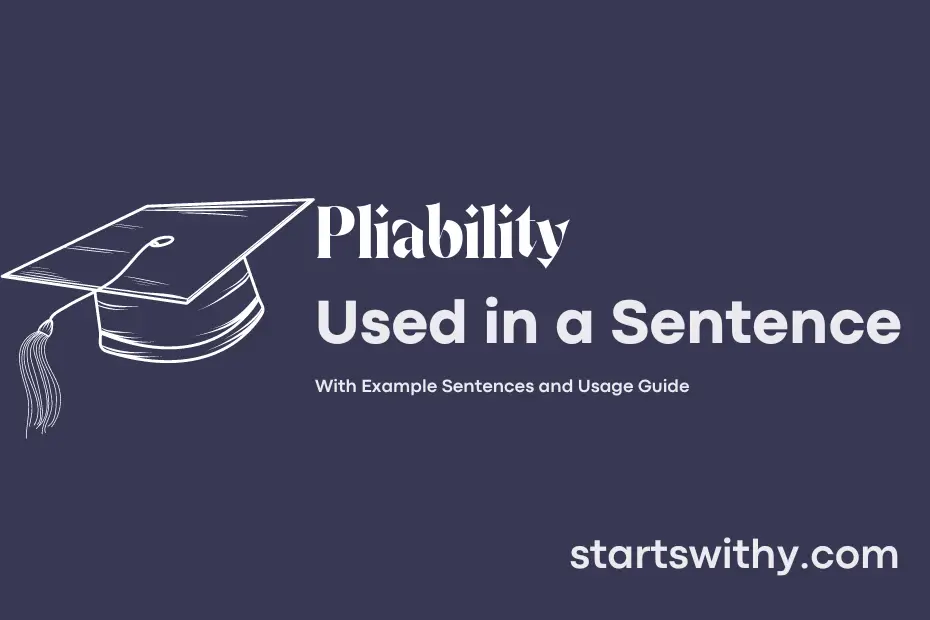Do you ever find yourself looking for ways to increase the flexibility and adaptability of your writing? If so, you might want to consider incorporating the concept of pliability into your vocabulary. Pliability refers to the quality of being easily shaped, bent, or influenced.
By incorporating pliability into your writing, you can enhance the fluidity and versatility of your sentences. This can help you creatively express ideas and concepts in a more dynamic and engaging manner.
7 Examples Of Pliability Used In a Sentence For Kids
- Pliability means being able to bend easily.
- Rubber bands have pliability because they can stretch and return to their original shape.
- Playdough is fun to mold because of its pliability.
- Our body needs pliability to move freely.
- Soft toys have pliability as they are easy to squeeze and hug.
- Yoga helps to improve the pliability of our muscles.
- Remember to be gentle with things that have pliability so they don’t break.
14 Sentences with Pliability Examples
- College students need to cultivate pliability in their thinking to adapt to the ever-changing job market.
- Developing pliability in your schedule can help you balance academics, extracurricular activities, and personal time effectively.
- It’s important to maintain pliability in your study habits to adjust to different subjects and professors’ teaching styles.
- Enhancing pliability in your communication skills can help you navigate group projects and presentations with ease.
- Having pliability in your career goals can open up new opportunities and help you explore different paths.
- Being open to feedback and criticism can enhance your pliability and make you a better student.
- Cultivating pliability in your approach to problem-solving can help you tackle challenging assignments more efficiently.
- Building pliability in your study environment can improve your focus and productivity.
- Embracing pliability in your decision-making process can lead to more informed choices.
- Participating in diverse extracurricular activities can foster pliability in your interests and skills.
- Adapting to new technologies and software can enhance your pliability in the digital age.
- Developing pliability in your time management can reduce stress and improve your overall well-being.
- Engaging in debates and discussions can sharpen your pliability in seeing different perspectives.
- Seeking out new experiences and challenges can increase your pliability and personal growth.
How To Use Pliability in Sentences?
Pliability means the quality of being easily bent or flexible. To use the word pliability in a sentence, follow these steps:
-
Identify a subject: Start by choosing a subject that you want to describe as flexible or easily adaptable.
-
Choose an action: Think about what the subject is doing or how it is behaving in a way that shows pliability.
-
Structure the sentence: Construct a sentence that includes the subject and the action, using the word pliability to describe the subject’s flexibility.
Example sentence: “The yoga instructor praised her student for the pliability of his body, noting how easily he was able to move into challenging poses.”
Remember that pliability can be used to describe not only physical attributes like flexibility, but also mental or emotional qualities such as adaptability or willingness to change. Experiment with different subjects and actions to see how versatile and useful the word pliability can be in expressing a variety of ideas.
Conclusion
In conclusion, the examples of sentences showcasing the keyword “pliability” illustrate the flexibility, adaptability, and resilience that this trait embodies. Whether describing a material’s ability to be molded or a person’s capability to adjust to change, pliability signifies a valuable quality that enables growth and successful navigation of challenges.
By exploring how pliability can be applied to different contexts, it becomes evident that embracing this characteristic can lead to favorable outcomes in various aspects of life. Cultivating pliability in our approach to situations and circumstances can enhance problem-solving skills, promote innovation, and help us effectively navigate the complexities of an ever-changing world.



